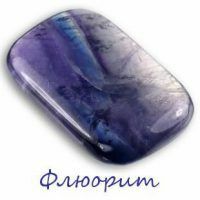
Fluorite - a stone of amazing beauty and extraordinary properties, thanks to which this mineral has found application in various spheres of human life.
- Stone history
- Mineral description
- Fluorite varieties
- Chemical composition and physical properties of
- stone Fluorite deposits
- Mineral therapeutic properties
- Fluorite magic properties
- Fluorite and zodiac signs
- Application of
- stone Interesting facts about
- stone How to distinguish natural fluorite from counterfeiting
- Stone care
- Photos of fluorite and products from it
History of stone
The first stone of fluorite was described by G. Agricola. This same famous German scientist called the stone - "fluorite", which in Latin means "flowing".This name of the stone is not accidental, because fluorite contributes to the fact that the ore during melting is easier to separate from the slag, making them really more "fluid".
The official name of the stone was received in 1546.But fluoride was used by mankind much earlier.
There is evidence that the vessels made from fluorite were also used by the ancient Romans. However, then it was called "murin" and was highly appreciated. Often, made of fluorite vases, boxes and jewelry, called "mourning", were on par with products made of gold.
Decorations made of fluorite, made, according to archaeologists, more than a thousand years ago, were discovered both in the territory of modern Czechia and on Ukrainian lands.
During the antique period, fluorite produced expensive jewelry. Soon the fashion passed, and this stone, thanks to its wide range of colors, was used by skilful masters only to make imitations of precious gems: emeralds, rubies, topazes, amethysts, sapphires.
Confirmations to this have been discovered quite recently. For example, it turned out that expensive dishes, once owned by Tsar Alexis Mikhailovich, and which for a long time were mistaken for amethyst, was made of fluorite.
Only at the end of the 16th century, after describing the stone and giving it the name "fluorite", the fashion was renewed with renewed vigor.
In ancient India, fluorite was revered not only for rare beauty, but also for its powerful magical properties.
Currently, fluorite is used in the chemical, smelting, jewelry and optics industries.
to contents ^Description of mineral
Externally fluorite is a transparent or translucent beautiful stone of a unique color scheme. Its blue, yellow, pink, purple, reddish-pink, blue-black hues have no analogues and simply amaze with its beauty.
Quite often you can find fluorites with unusual, unique patterns, created splotches, spots and stripes of different colors, as well as the zoning color - the transition from less saturated to a more intense degree of color.
The name of the stone comes from the Latin word "fluor", which literally translates as "flow", and is associated with its high melting properties. Other names for the stone are associated with them: "plavik", "melting spar".
Given that in the old days fluorite was often used to simulate precious stones, this mineral was also called the transvaal, fake and South African emerald, the "false-topaz", "false ruby", "false sapphire", "falsh-amethyst"and described it G. Agricola called the stone "ore flower".
As a separate unique mineral, fluorite took its place of honor among gems only after its unique properties were discovered - a glow in the dark and the ability to leave an indelible trace on the glass after dissolving in sulfuric acid.
to contents ^Fluorite varieties
There are several varieties of fluorite, based on the color range:
- anthozonite - fluorite of dark purple color;
- chlorophane - fluorite of green color, which becomes brighter when heated;
- blue John( Blue John) - a fluorite of unusual color, which is a two-color crystals, which combine violet-white or violet-yellow shades;
- ratovit - fluorite from violet-pink to violet-blue hue, earthy variety of mineral;
- It is a fluorite variety, in which 15-18% of calcium is replaced by cesium or yttrium;
- It is a type of fluorite in which, conversely, yttrium is partially replaced by calcium.
Chemical composition and physical properties of stone
The fluorite is fluoride of calcium in its species. Its chemical formula is CaF2.
Fluorite is colorless in its classical form( without impurities), however, the impurities contained in it color the stone in a wide variety of colors: green, turquoise, golden yellow, pink, blue, dark purple. This color of fluorite is due to the presence in its chemical composition of rare-earth elements, as well as uranium, strontium, chlorine, thorium, samarium and iron. It is often inhomogeneous, with zonal staining.
Fluorite crystals are transparent or translucent with a beautiful characteristic glass shine. They are quite fragile, but they have a rather high density - from 3.1 to 3.2 g / cm3.
High and melting point of fluorite is about 1360 ° C.But the hardness of the mineral is not very high and is 4 units on the Mohs scale.
It should be noted that fluorite easily dissolves in hydrochloric acid, leaving an indelible trace on the glass. The main distinctive physical properties of this stone are:
- fluorescence - glow in the dark;
- photoluminescence - luminescence due to ultraviolet radiation;
- thermoluminescence - glow when heated.
Fluorites with defects in the crystal structure are often encountered, which contributes to the reaction of the stone to heating and radioactive irradiation. With a similar effect, the color of the stone changes. So, when heated to 700 ° C, fluorite fades and can completely discolor, and under the influence of X-rays - restore color.
to contents ^Fluorite deposits
Large deposits of fluorite are found in hydrothermal ore veins, as well as in dolomites and limestones of Uzbekistan, Kirgizia, Kazakhstan, Russia( Chita Region, Primorye, Northern Caucasus).
Fluorite deposits occur in Germany, Great Britain, Greenland, Norway, Italy, USA, Canada and Tajikistan.
to the table of contents ^The healing properties of the mineral
Folk healers recommend fluorite as a remedy for getting rid of acute headaches and migraine headaches.
It is believed that this stone:
- has a positive effect on brain activity;
- helps with epilepsy;
- has a positive effect on the cardiovascular system;
- is useful in multiple sclerosis.
Lithotherapists suggest that the therapeutic properties of the mineral:
- normalize sleep;
- relieve chronic insomnia;
- helps to cope with nightmares;
- facilitate the state of meteodependent people;
- neutralizes the negative consequences of stressful situations;
- tone the nervous system.
For therapeutic purposes, special balls are made of fluorite for performing stone massage of the face and body surface area.
to contents ^Magical properties of fluorite
Since ancient times, strong magical properties have been attributed to fluorite. Even the mages revered and feared him. Quite often, for carrying out spiritualistic sessions, predicting the future and conducting meditations, fluorite balls were used.
Modern esotericists believe that amulets of fluorite:
- helps to find harmony with nature;
- protects from harmful influence of negative energy;
- helps to cope with emotions;
- increases mental and analytical abilities;
- attracts good luck in love.
Fluorite and zodiac signs
According to astrologers, fluorite is suitable as a talisman for all signs of the zodiac. Most positively, this stone affects Gemini, Aquarius and Pisces.
to the table of contents ^Application of the stone
In the modern world, fluorite has found extensive application in many industries:
- In jewelery. Today, fluorite jewelry - earrings, pendants, beads, bracelets, brooches and cufflinks can be found in virtually every jewelry store.
- In the collection. Recently, interest in fluorite as a collectible stone has increased. The price for 1 carat on average is 20-30 dollars.
- In the arts and crafts. For many hundreds of years, vases, bowls, caskets, figurines, hand-made articles, fragrance bottles and other decorative items have been made from fluorite.
- In metallurgy. Fluorite is still used to form low-melting slags as a flux( flux).
- In the chemical industry. Fluorite is used to produce fluorine, aluminum, artificial cryolite and a number of fluoride compounds.
- In ceramic production. Fluorite is used for making glazes and enamels.
- In optics. Transparent colorless fluorite is used to make lenses.
- In the industry. Fluorite crystals containing rare earth and iron impurities are used to fabricate quantum generators.
- In engraving on the glass. With the help of hydrofluoric acid, obtained from fluorite under the influence of sulfuric acid, an etched pattern is applied to the glass.
Interesting facts about the stone
- A beautiful fluorite vase 75 cm high is exhibited at the Geological Museum of London.
- The highlight of the Museum of the Mining Institute( St. Petersburg) is a transparent fluorite crystal of a gently blue color of enormous size. Its weight is more than 300 kg.
- In the Middle Ages there was an opinion about the diabolical nature of the mineral. Such an affirmation of the medieval alchemists was facilitated by the ability of fluorite to release the strongest poison gas of hydrogen fluoride during the interaction with sulfuric acid.
- The special properties of fluorite include its ability to fluoresce( glow) in the dark under the influence of ultraviolet and high temperatures. From the name of the mineral "fluorite" there was, in fact, the term "fluorescence", proposed in 1852 by George Stokes - the famous English theoretical physicist.
How to distinguish natural fluorite from counterfeiting
- To distinguish natural fluorite from counterfeiting its unique properties and, above all, fluorescence will help. The heated natural stone will necessarily glow in the dark.
- Natural fluorite is also distinguished by photoluminescence. Under the influence of ultraviolet light, the stone strongly fluoresces with purple.
- Natural fluorite is not a very hard stone, so when you look closely you can see the rubs or scratches on its faces. It can easily be scratched with glass or a sharp object, but this is not the best way to check its naturalness.
- Natural fluorite is highly dense, so with the same size for weight, it will be heavier than glass and especially plastic.
Stone care
Fluorite is a fairly fragile stone and requires a very careful attitude and special care.
- Fluorite and its products must not be exposed to very low( below -5 degrees) and very high( above +40 degrees) temperatures.
- Natural fluorite is a brittle mineral, which, if struck hard or falls on a hard surface, can split, so it must be protected against falls and shocks.
- Natural fluorite is easily scratched, so it must be stored separately from other stones and preferably in a soft case.
- When cleaning fluorite and products with it, do not use chemicals, even soap. The only thing that can be done to clean the stone of dirt is to wipe it with a damp soft cloth.
It is useful once a week to "discharge" the fluorite under running water and "charge" it for one or two hours under the sun's rays.
to contents ^Photos of fluorite and products from it
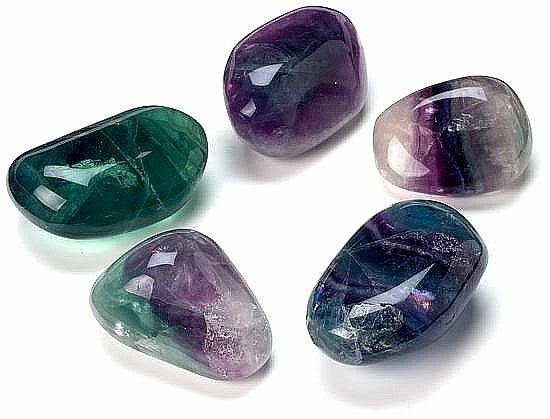

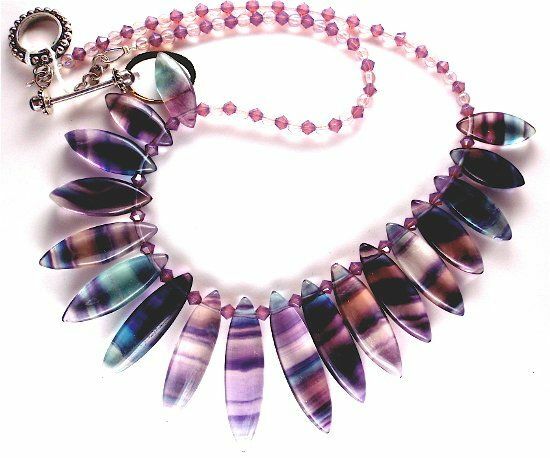
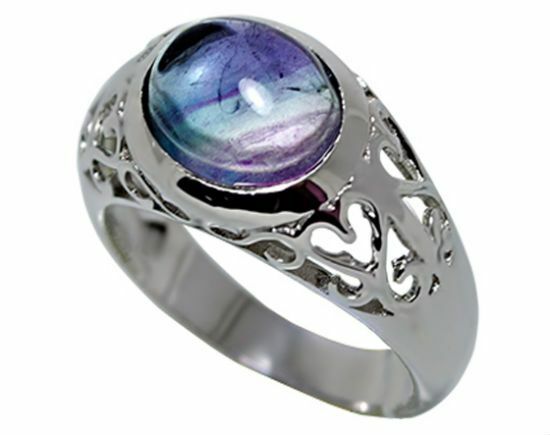
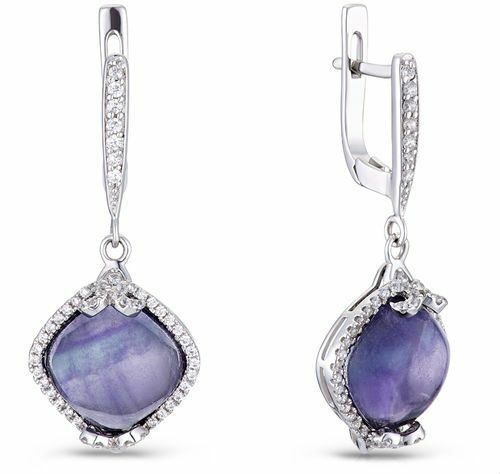

Very beautiful stone! For the first time I hear about this, and would not refuse to buy a product for one of it. Earrings, or pendant, or ring. Moreover, so many good properties are observed. I believe in the strength of the stones and try to decorate the jewelry so that the stones in them contained, I somehow helped))